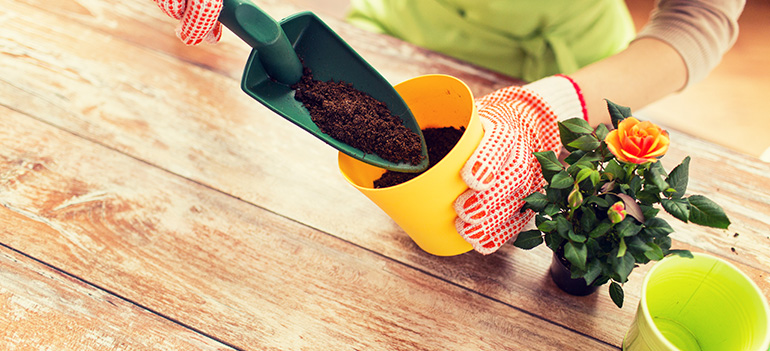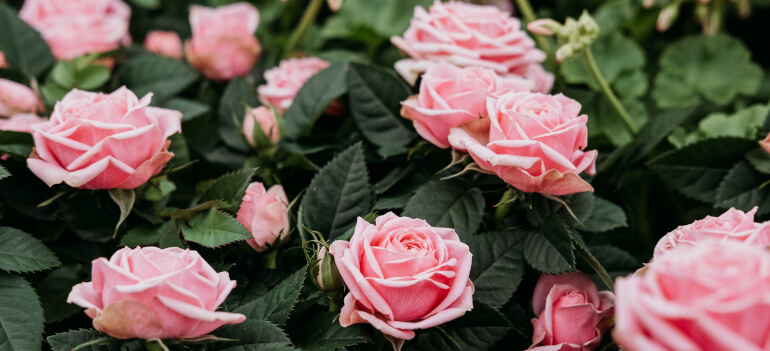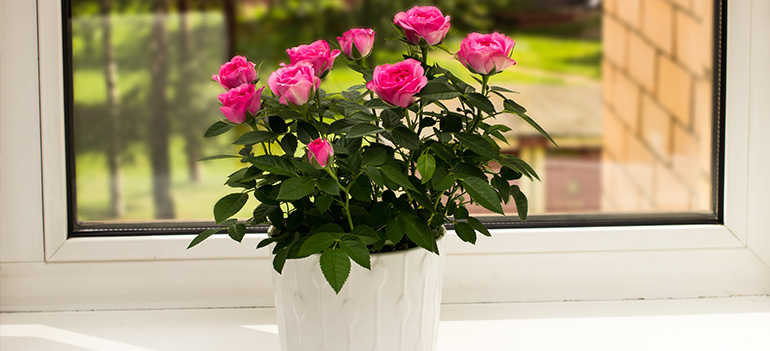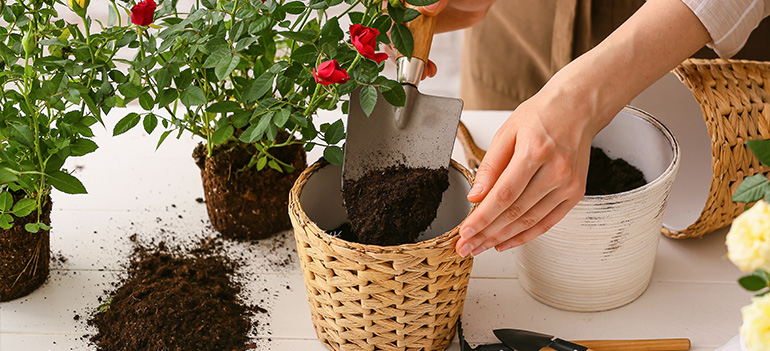Apart from parks, gardens and arcs’ decoration, from blossoming in sideways alleys and massive lanes and from mass rose oil production, the queen of flowers makes its way into the family of indoor plants.
Consider a rose if you’re looking for a beautiful indoor plant that will add some colour to your home. Roses come in various colours and sizes, so you can find one that fits your space and style. Most varieties of roses can thrive indoors with proper care. Here are some tips on choosing and caring for indoor roses.
Table of Contents
Can you grow roses indoors?
Adding a splash of green to your indoor spaces is a great way to liven things up. And what better way to do that than with some beautiful roses! Roses can grow just as well indoors as they would outdoors, as long as you take proper care of them. So if you’ve been wondering if you can grow roses indoors, the answer is yes!
What varieties of roses grow well inside?
There are many different varieties of roses that can thrive indoors, as long as they are suited to the conditions you can provide. Most rose plants prefer a sunny location, but several species do well with artificial light. There are plenty of types of roses that can be grown in containers.
Here are some of the best:
- Ground cover roses: These stay low to the ground and can spill over the edges of your pot for a beautiful effect. Depending on the size of your pot and the variety of ground cover roses, you may even be able to use it as a border around a larger plant.
- Patio roses: If you want a rose bigger than a miniature but not as large as a standard rose, try a patio rose. This type of floribunda rose has been bred to be smaller in scale.
- Polyantha: These roses bear clusters of small flowers and come in both climbing and non-climbing varieties.
- Miniature roses: As their name suggests, these roses stay relatively small, making them perfect for container gardening.
The most popular rose variety for indoor gardens is the miniature rose! These smaller plants are easier to care for and more convenient for indoor spaces with less room. They are disease resistant, very hardy, and approximately 50cm x 50cm tall, making them ideal for any apartment or windowsill.
Miniature roses require the highest amount of light, so choose these only if you have lots of sunshine or grow lights. Miniature roses grown indoors still require approximately 6-8 hours of sunlight per day, so placing them in a south-facing window or investing in special grow lights is essential. Otherwise, select a species that can thrive in partial shade.
Try climbing roses if you have some vertical space but not as much floor space! They need a trellis or grid of some sort to hold onto and climb, but they are otherwise no more difficult to care for than any other rose. Miniature climbing species can be grouped in larger containers for a tapestry of living colour.
What do roses need to grow well indoor?
Plant in a good soil
Grown indoors in pots, the roses require more care than the outdoor ones, but compensate with a unique environment in your home. Depending on the sort, you will have to pick the container, too. Use a soil mixture that is rich in nutrients and slightly permeable. The most adequate recipe will be 2 parts of lawn soil, 2 parts of well-decomposed animal waste, 1 part of mould and 1 part of sand.
The most appropriate time to plant the roses is during autumn or during spring. Cut the roots in advance, and leave around 3 to 4 buds over the ground. Place a piece for drainage over the pot’s opening. After that put a layer of sand – around 1-2 cm, and then the soil mixture. Pat well around the roots. Leave around 2 cm of space between the soil and the pot’s edge, and immediately water the pot.
During the summer season, you can take out the blossoming roses on the balcony or in the garden. In this case it’s recommended to bed them into boxes with sand. It has to be always moist so that the plants will be protected from any extra overheating.
Choose the right containers
Select a large pot with plenty of room for the roots to spread to ensure your rose bush grows tall and strong. A pot that is at least 15 inches in diameter is ideal. Roses have deep roots, so the taller the container, the better.
The soil in pots heats up faster than garden soil, so clay pots are generally better than plastic since clay is slower to transfer heat from the sun into the soil. If you must use plastic pots, use lighter-coloured plastic, which won’t heat up as fast as dark plastic. Make sure the pots have ample drainage holes in the bottom.
You have to be aware of what the container is made of and its material’s properties to take adequate measures when growing roses inside.
- Wooden pots – such as kegs and boxes, have a bad thermal conductivity, and because of that, the roots don’t suffer from sudden temperature changes.
- Stone containers – beds and vases – the temperature influences them, as they are comparatively easy to heat and cool.
- Ceramic containers – the ones without any coating let the air reach the roots and ease their breathing.
- Plastic containers – easy, light, durable and cheap. The soil substrate dries out slower in them, but they also heat quickly under the sun.
When growing roses in pots, you have to bear in mind that those plants are cold-resistant and can stay outside in the winter without freezing out. For them, the hot summer days are riskier when, due to overheating of the pot, it’s possible to accidentally roast the roots of the plant, which will lead to it dying out. This requires putting the pots under shade and regularly watering them.
If you buy roses in a pot directly from the store, you must immediately transfer them to a larger pot when you get back home. Pour water in it a few hours beforehand so the soil can remain solid around the roots.
Optimum light
Light is essential for plant growth, so for your roses to be healthy, you should place them near a south-facing window with good ventilation. This will allow the plant to bask in 6-8 hours of sunlight. If you don’t have any south-facing windows or little natural light in your home, your roses can be grown using growing light.
Careful watering
Watering indoor roses can be tricky. They need ample soil moisture to bloom well, so take special care not to overwater or underwater your houseplants. Indoor roses require a lot of water to stay healthy, and because they’re kept in containers, they can dry out quickly.
Check the topsoil every few days and water thoroughly when the top inch has dried out. Be sure the compost is moist but not wet. In winter, reduce the watering frequency as transpiration rates are not as high as in summer.
Humidity
Roses kept indoors require a more humid environment than those kept outdoors. If the humidity levels drop, the leaves may start to drop, and the blooms may shrivel. To keep the humidity up, place your rose on a tray of pebbles with water in it.
Indoor roses, especially miniature ones, like humidity levels between 40-50%. Misting your rose plants is not recommended as it can lead to fungal growth on the foliage.
Controlled temperature
Roses require specific growing conditions to thrive. They prefer daytime temperatures between 65-75°F (18-24°C). The nighttime temperature should not fall below 60°F (15°C). It is important to protect Roses from fluctuating temperature levels.
In the winter, keep your rose plant away from drafts, both cool and warm. Also, avoid places that get too hot.
Trimming and pruning
If you want your plant to look its best, remove dying flowers as soon as they fade. Plucking them off with your hands can tear and damage the stem, so use sharp pruners and trim at a 45° angle.
For new plants, no pruning is needed. But as they age, removing any dead branches or flowers is important. After the plant has flowered each autumn, give it a generous trim. Yearly pruning will promote vigorous growth and keep flowers healthy. When pruning, use clean shears and always cut 1/4-inch above a leaf axil at a 45° angle.
Trimming happens just before vegetation. Depending on the rose sort, the height you trim them varies. Polyantha roses should be cut from the 3rd bud, the tea hybrid ones – at the 3rd or 4th, perennial ones – not before the 5th or 6th. The sorts that blossom all the time need trimming during the whole summer. The overblown flowers are trimmed together with a couple of unformed growing buds beneath them. This way, you will provide for the next rich blossoming.
Feeding
During flowering time, feed the roses a couple of times with mineral fertilizers – 2 grams diluted in 1 litre of water. During autumn, when the leaves fall down, lower the watering. This way, the plants prepare to pass through the necessary break period, which they can also spend in the open air.
If you prefer the roses to begin blossoming during the winter-spring period, you need to bring them inside the rooms during the desired time and begin to water them, by gradually raising the water dose.
Repotting
One of the best ways to show your love for someone is by giving them roses. But did you know that potted plants or gift baskets sometimes contain more than one rose plant per pot? This is actually a great time to divide them!
By carefully teasing apart the roots with your fingers and removing as much of the original soil as possible, you can replant each rose in its own small pot with drainage holes. Be sure to do this in the fall, after the flowering season is over. You can then repot biannually in spring using a ‘Houseplant’ labelled potting mix and the next sized pot with adequate drainage.
Indoor roses are far better potbound for several years due to the heightened risk of root rot and repotting issues (like transplant shock).
Pests & problems
Allowing dust to gather on the leaves of your house plants provides the perfect breeding area for spider mites, aphids and mildew, all of which have a detrimental effect on the health of your plants. Once or twice a week carefully wash the leaves by spraying them with soapy water and wiping with a soft cloth, plants rely on their leaves to breathe so keeping them clean and clear of dust helps to aid growth as well as keeping harmful pests at bay.
Moving indoor roses outside
If you’re looking to move your roses outdoors for the warmer months, be sure to start by placing them in complete shade outside. Your plant will need time to adjust to the new environment and harden off; otherwise, the rose will quickly burn.
After a few days in complete shade, gradually increase the amount of sun exposure so as not to shock and damage the leaves of your plant. Once temperatures start to drop, return your plant indoors.
Need a Gardener?
Enter your postcode to view our rates and availability in your area.
For questions about the services we offer visit our main site








Can I grow a David Austin rose in a pot in my conservatory?
Of course, Valerie! We’d go for Rose Harlow Carr or Lady Emma Hamilton breeds, but indeed, you can check with many other roses.
Im growing my roses from seed indoors. Ive read that once the sprout 4 or 5 leaves, i can fertilize. Im looking to make liquid fertilizer out of Jobe’s spikes. What concentration should I use to prepare this? Im thinking 2 spikes per 4 Litres water, and then adding 1/3 cup to my watering can every 1-2 weeks. Any advice for the novice on this is greatly appreciated.
It’s arguably the best fertilizer you could use, Lynn. Check the ratios on the package, they usually work for indoor potted roses, too.
Your writing is great, I learned how to grow roses. I will make my garden a lot of roses, will help me relax and look every day.
Hi. Thanks for the blog.
I have an indoor potted plant which I think is Rose. Not sure having looked at photos.
Is it possible to give me an idea if I post a photo?
Stephen.
Go ahead, Stephen, we will try to recognise the plant!
The leaves are turning yellow and falling off. The flowers are not reproducing. I don’t know if I am overwatering or underwatering.
Thank you for sharing such knowledge with all the viewers as it will definitely help in planting a beautiful garden of roses.
Keep sharing such work.
Can I grow hybrid tea roses in a plastic plant pot indoors in February? And when will I need to transfer them to a larger pot or to my garden? I’m a complete beginner